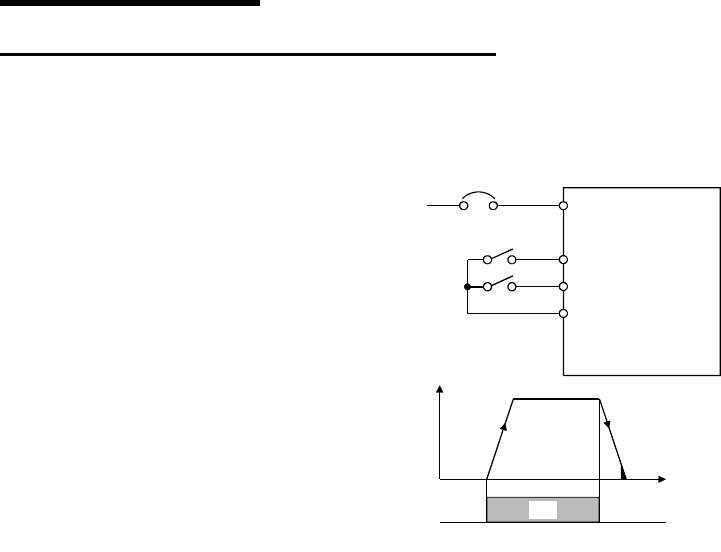
28
1
.7 Input Terminals
1
.7.1 Run (start) and stop (STF, STR, STOP)
To start and stop the motor, first switch on the input power supply of the inverter
(switch on the magnetic contactor, if any, in the input circuit during preparation for
operation), then start the motor with the forward or reverse rotation start signal.
(1) Two-wire type connection (STF, STR)
A two-wire type connection is shown on
the right.
1) The forward/reverse rotation signal is
used as both the start and stop
signals. Switch on either of the
forward and reverse rotation signals
to start the motor in the corresponding
direction. Switch on both or switch off
the start signal during operation to
decelerate the inverter to a stop.
2) The frequency setting signal may
either be given by entering 0 to 5VDC
(or 0 to 10VDC) across frequency
setting input terminal 2-5 or by setting
the required values in Pr. 4 to Pr. 6
"multi-speed setting" (high, middle,
low speeds). (For multi-speed
operation, refer to page 32.)
ON
NFB
Power
supply
Forward
rotation start
Reverse
rotation start
STF
STR (Pr.63= "- - -" )
SD
R<L
1
>,S<N>,T
Inverter
Output frequency
Across
STF-SD
(STR)
Time
2-wire t
yp
e connection exam
p
le
3) After the start signal has been input, the inverter starts operating when the
frequency setting signal reaches or exceeds the "starting frequency" set in Pr. 13
(factory-set to 0.5Hz).
If the motor load torque is large or the "torque boost" set in Pr. 0 is small, operation
may not be started due to insufficient torque until the inverter output frequency
reaches about 3 to 6Hz.
If the "minimum frequency" set in Pr. 2 (factory setting = 0Hz) is 6Hz, for example,
merely entering the start signal causes the running frequency to reach the minimum
frequency of 6Hz according to the "acceleration time" set in Pr. 7.
4) To stop the motor, operate the DC injection brake for the period of "DC injection
brake operation time" set in Pr. 11 (factory setting = 0.5s) at not more than the DC
injection brake operation frequency or at not more than 0.5Hz.
To disable the DC injection brake function, set 0 in either of Pr. 11 "DC injection
brake operation time" and Pr. 12 "DC injection brake voltage".
In this case, the motor is coasted to a stop at not more than the frequency set in
Pr. 10 "DC injection brake operation frequency" (0 to 120Hz variable) or at not more
than 0.5Hz (when the DC dynamic brake is not operated).
5) If the reverse rotation signal is input during forward rotation or the forward rotation
signal is input during reverse rotation, the inverter is decelerated and then switched
to the opposite output without going through the stop mode.


















